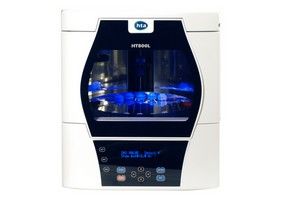HT800L from HTA
The new HT800L from HTA is a fast and versatile HPLC autosampler for highly precise injections into HPLC, UHPLC and LC/MS systems.

The new HT800L from HTA is a fast and versatile HPLC autosampler for highly precise injections into HPLC, UHPLC and LC/MS systems.
The autosampler can easily fit into any existing HPLC system and offers outstanding performance, high sample throughput and reproducibility ensuring you can achieve optimum results.
Available in biocompatible and cooling versions, the HT800L is able to handle up to 120 vials per run and work with different types of microplate. The HT800L offers flexibility whilst maintaining its compact and stackable design.
Complete with a user friendly PC interface, the autosampler is extremely easy to operate. The interface allows full graphical control of samples, methods and sequences.
The HT800L can also manage three different injection modes: full loop, partial loop and microliter pick-up with outstanding results (low cycle time, precise analytical performance).
The standard HT800L also offers unparalleled sample handling, allowing virtually any combination of sample preparation and liquid handling that the most demanding HPLC applications may require. Up to 11 reagents are available for dilution, derivatization, pH spiking and internal standard addition.
For further communication:
HTA s.r.l.
Via del Mella 77
25131 Brescia
ITALY
T: +39-030-3582920
F: +39-030-3582930
W: http://www.hta-it.com
E: info@hta-it.com
Contact person: Enrico Marchini
E: adv@hta-it.com

A Novel LC–QTOF-MS DIA Method for Pesticide Quantification and Screening in Agricultural Waters
May 8th 2025Scientists from the University of Santiago de Compostela developed a liquid chromatography quadrupole time-of-flight mass spectrometry (LC–QTOF-MS) operated in data-independent acquisition (DIA) mode for pesticide quantification in agriculturally impacted waters.
Investigating 3D-Printable Stationary Phases in Liquid Chromatography
May 7th 20253D printing technology has potential in chromatography, but a major challenge is developing materials with both high porosity and robust mechanical properties. Recently, scientists compared the separation performances of eight different 3D printable stationary phases.

.png&w=3840&q=75)

.png&w=3840&q=75)



.png&w=3840&q=75)



.png&w=3840&q=75)



